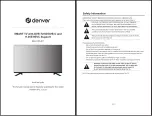
Safety Instructions, Warnings, and Notes
EN 4
L04E AB
2.
2.
Safety Instructions, Warnings, and Notes
2.1
Safety Instructions
Safety regulations require that
during
a repair:
•
Connect the set to the Mains (AC Power) via an isolation
transformer (> 800 VA).
•
Replace safety components, indicated by the symbol
h
,
only by components identical to the original ones. Any
other component substitution (other than original type) may
increase risk of fire or electrical shock hazard.
Safety regulations require that
after
a repair, the set must be
returned in its original condition. Pay in particular attention to
the following points:
•
Route the wire trees correctly and fix them with the
mounted cable clamps.
•
Check the insulation of the Mains (AC Power) lead for
external damage.
•
Check the strain relief of the Mains (AC Power) cord for
proper function.
•
Check the electrical DC resistance between the Mains
(AC Power) plug and the secondary side (only for sets
which have a Mains (AC Power) isolated power supply):
1.
Unplug the Mains (AC Power) cord and connect a wire
between the two pins of the Mains (AC Power) plug.
2.
Set the Mains (AC Power) switch to the "on" position
(keep the Mains (AC Power) cord unplugged!).
3.
Measure the resistance value between the pins of the
Mains (AC Power) plug and the metal shielding of the
tuner or the aerial connection on the set. The reading
should be between 4.5 Mohm and 12 Mohm.
4.
Switch "off" the set, and remove the wire between the
two pins of the Mains (AC Power) plug.
•
Check the cabinet for defects, to avoid touching of any
inner parts by the customer.
2.2
Warnings
•
In order to prevent damage to ICs and transistors, avoid all
high voltage flashovers. In order to prevent damage to the
picture tube, use the method shown in Fig. 2-1, to
discharge the picture tube. Use a high voltage probe and a
multi-meter (position V_dc). Discharge until the meter
reading is 0 V (after approx. 30 s).
Figure 2-1 Discharge picture tube
•
All ICs and many other semiconductors are susceptible to
electrostatic discharges (ESD,
w
). Careless handling
during repair can reduce life drastically. Make sure that,
during repair, you are connected with the same potential as
the mass of the set by a wristband with resistance. Keep
components and tools also at this potential. Available ESD
protection equipment:
–
Complete kit ESD3 (small tablemat, wristband,
connection box, extension cable and ground cable)
4822 310 10671.
–
Wristband tester 4822 344 13999.
•
Together with the deflection unit and any multi-pole unit,
flat square picture tubes form an integrated unit. The
deflection and the multi-pole units are set optimally at the
factory. We do not recommend adjusting this unit during
repair.
•
Be careful during measurements in the high voltage
section and on the picture tube.
•
Never replace modules or other components while the unit
is 'on’.
•
When you align the set, use plastic rather than metal tools.
This will prevent any short circuits and the danger of a
circuit becoming unstable.
2.3
Notes
2.3.1
General
•
Measure the voltages and waveforms with regard to the
chassis (= tuner) ground (
H
), or hot ground (
I
), depending
on the tested area of circuitry. The voltages and waveforms
shown in the diagrams are indicative. Measure them in the
Service Default Mode (see chapter 5) with a colour bar
signal and stereo sound (L: 3 kHz, R: 1 kHz unless stated
otherwise) and picture carrier at 475.25 MHz for PAL, or
61.25 MHz for NTSC (channel 3).
•
Where necessary, measure the waveforms and voltages
with (
D
) and without (
E
) aerial signal. Measure the
voltages in the power supply section both in normal
operation (
G
) and in standby (
F
). These values are
indicated by means of the appropriate symbols.
•
The semiconductors indicated in the circuit diagram and in
the parts lists, are interchangeable per position with the
semiconductors in the unit, irrespective of the type
indication on these semiconductors.
•
Manufactured under license from Dolby Laboratories.
“Dolby”, “Pro Logic” and the “double-D symbol”, are
trademarks of Dolby Laboratories.
Figure 2-2 Dolby PL Symbol
2.3.2
Schematic Notes
•
All resistor values are in ohms and the value multiplier is
often used to indicate the decimal point location (e.g. 2K2
indicates 2.2 kohm).
•
Resistor values with no multiplier may be indicated with
either an "E" or an "R" (e.g. 220E or 220R indicates
220 ohm).
•
All capacitor values are given in micro-farads (
µ
= x10
-6
),
nano-farads (n= x10
-9
), or pico-farads (p= x10
-12
).
•
Capacitor values may also use the value multiplier as the
decimal point indication (e.g. 2p2 indicates 2.2 pF).
•
An "asterisk" (*) indicates component usage varies. Refer
to the diversity tables for the correct values.
•
The correct component values are listed in the Electrical
Replacement Parts List. Therefore, always check this list
when there is any doubt.
V
E_06532_007.eps
250304
E_06532_006.eps
240604




































